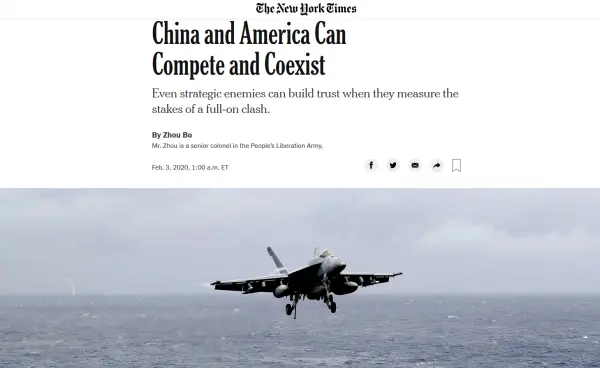【文/周波,译/观察者网 韩桦】
忘掉贸易战吧。如果21世纪最严峻的挑战是如何寻找中美竞争中共存的办法,真正的危险则是一场意外事件引发了冲突,造成双方都始料不及,也难以把控的后果。最可能的潜在爆发点当属中国南海。
《纽约时报》2月3日头版刊登评论文章“中美能够竞争共存”
中方坚信,并在其2014年的立场文件中阐明,中国对南海诸岛及其附近海域拥有“无可争辩的主权”。中国政府表示其立场具有坚实的历史和法理依据,因为“中国是最早发现、命名、勘探和开发南海诸岛资源的国家,也是最早并持续对南海诸岛实行主权管辖的国家”。
一些沿海国家对此持有不同意见—最明显的是菲律宾,也包括越南,文莱,马来西亚,以及最近表示异议的印度尼西亚。他们基于本国历史和地理的记述,也提出其领土声索,这些声索有时相互矛盾。
而美国则一直宣称不在这些主权争议上选边站队,并声称它只想确保地区水域的航行自由。
但是中国以多种方式谴责美国这种自诩的“中立”为虚伪。美国学者傅泰林(Taylor Fravel)也指出,美国政策中似乎有一种固有的矛盾:一方面声称要置身地区争议之外,另一方面在该地区的行动又不断抬头,尤其是在美国认定中国为“该地区紧张局势加剧的根源”之后。
此外,每当美国军舰驶进中国控制的南海岛礁附近,或者进入中国军舰巡逻的水域时,危险相遇的风险就会加剧。
2001年,美国海军侦察机和中国战斗机相撞,造成中国飞行员牺牲。中方当时扣留了美方飞行员和机组成员。华盛顿方面并未正式对事件和牺牲飞行员道歉和负责,但在表示了两次“非常遗憾”之后,紧张的外交对峙才慢慢得以化解。此后,在2001年,接着是2009年,2013年,2014年,2015年和2018年,中美军舰和军机在南海多次近距离相遇。
特朗普执政期间,美国海军明显增加了在中国的主权水域“航行自由”行动的次数,这些行动增加了冲突的风险。2018年9月,美国海军驱逐舰“迪凯特号”和中国海军驱逐舰“兰州号”在南海险些相撞,最近距离仅45码(约41米),可谓近年来最惊险遭遇。
如果今天在中国南海再发生一次碰撞,中美双方绝不会像2001年那样容易解决冲突。在华盛顿进攻性地故意激化同北京的竞争,但一个不断崛起的中国只会更加坚定地捍卫自身主权。修昔底德指出,战争动因不外乎三者:恐惧、荣誉和利益,中国南海一应俱全。
中国近年来大力发展武器装备和海军舰队并在南海建立哨所一定程度上促使了特朗普政府在其2017年《国家安全战略报告》和2018年《国防战略报告》中,定性中国为“战略竞争对手”,美国还称中国是“修正主义国家”。
中国继而在2019年发布的国防白皮书中回敬美国是“奉行单边主义政策”和“挑起和加剧大国竞争”。
双边竞争似在升温,那么问题来了:中美如何避免冲突,或者一场新的冷战?答案恰恰是,重温冷战。
冷战初期,美苏战机毫不迟疑向对方开火.。因为柏林的地位和东西柏林分割问题,两国在1948年,1958年和1961年发生过三次危机。1962年10月爆发的古巴导弹危机把当时的两个超级大国带到了核战争边缘。由于一些还算适用的协议,加上牢固可靠的紧急通讯热线,双方避免了直接冲突。这说明尽管冷战期间双方手段有限,但在衡量全面冲突之利害后,死对头也能建立信任。
1972年,华盛顿和莫斯科签署了《防止公海及其上空事件的协定》,在达成的诸多事项中包括承诺使用清晰的通讯信号,以防止任意一方“骚扰或危及”即便已受到监视的船只,“最大程度小心、谨慎地接近”公海上的舰船。协定极大地降低了冷战时期美苏危险相遇的风险,后来虽然没能防止1988年2月发生的两艘苏联军舰在黑海撞击两艘美国军舰那样的例外事件,但据时任美国海军战争学院法学教授佩德罗佐2012年发布的一份报告,在协定签署后的两年之内,每年的意外事件发生次数由100次显著降低到了40次。
苏联和美国在冷战时期都能设法避免热战发生,相比之下,中美关系远不及那么对抗,因此今天双方仍有理由对双边关系保持一定信心。
中美目前的军事竞争囿于西太平洋,因此有别于美苏在全球范围内的军备竞赛。美国以为中国想把他赶出西太平洋,中国则认为美国不仅想阻止其正当合理发展远洋海军的雄心,还想把中国的影响力限定在亚洲大陆东海岸以内。
虽然中国以令人惊叹的速度壮大军事实力,却没有任何想取代美国成为世界警察的欲望。中国军队远离本土的军事行动,例如在亚丁湾、非洲大陆等,都仅限于应对如海盗、维和及自然灾害等威胁。反之,美国海军则是定期派军舰到亚太海域蓄意“挑战”——用他们自己的话说——某些沿海国家的“过度海洋声索”。
哪怕是最右翼的观察家也不会把中美描述成真正的敌人。在去年10月的香山论坛—中国版“香格里拉对话”会上,国防部长魏凤和表示,“中美军事关系总体稳定,但也面临不少困难和挑战”。
相比冷战时期的苏联和美国,中美之间现有的互信措施要“原始”得多。从某种意义上讲,这或许是一种安慰,说明两国关系还没那么糟,因此不需要那些多措施。但是,从长远来看,中美两国还是有必要建立更多的互信措施。
1998年,中美两国基于“相互尊重的精神”,签署了《关于建立加强海上军事安全磋商机制的协定》,以“建立一个稳定的双边海军和空军磋商渠道”。2014年,双方又达成不具法律约束力的《海上意外相遇规则》和《海空相遇安全行为准则谅解备忘录》。
即便中美两国在1998年签署了协议,之后两国军机仍然相撞;2014年的两份准则签署之后,两军舰机也有过数次危险接近。换言之,仅靠互信措施,既不能避免意外事件,也不能消除战略互疑,过去如此,现在也一样。但是,互信措施依然是在中美利益分歧下防止双方擦枪走火,继续发展工作关系的基础。
中国军力正在继续发展,与美国军力差距逐步缩小,因此双方亟需更多规则,不仅适用两国已合作的打击海盗或者抢险救灾领域,而且要应用于太空探索、网络空间和人工智能等领域。
中国人传统上笃信阴阳学说,因此认为竞争与合作并不矛盾。但是这对美国来说却似乎是个问题。华盛顿和一些西方国家的官僚们,对于中国没有亦步亦趋紧随美国,或至少更“民主”一些都表示沮丧。但中国何时拍过胸脯说要变得跟美国一样?中国不像美国又有何妨?竞争中共存,仍有可能。
(观察者网译自《纽约时报》,翻页阅读英文原文)
China and America Can Compete and Coexist
Forget the trade war. If the gravest challenge of the 21st century is finding ways that China and the United States can coexist competitively, the real danger is that an unexpected incident might trigger a conflict that neither side has anticipated or could possibly control. The likeliest potential flash point is the South China Sea.
China believes, and has said as much in a 2014 position paper, that it has “indisputable sovereignty” over the South China Sea islands and the adjacent waters. This claim is solidly grounded in history and law, the government argues, because “China was the first country to discover, name, explore and exploit the resources of the South China Sea islands and the first to continuously exercise sovereign powers over them.”
Some coastal states in the region disagree — most notably perhaps the Philippines, but also Vietnam, Brunei, Malaysia and more recently, Indonesia. They defend other, sometimes competing, territorial claims, based on their own accounts of history and geography.
The United States, for its part, has historically vowed not to take sides in these disputes over sovereignty, arguing that it only wants to protect free navigation in the region’s waters.
But China has denounced America’s professed commitment to neutrality as hypocritical in several ways. And as academics like M. Taylor Fravel have argued, there seems to be something of an inherent contradiction in the United States’ policy: between its claim to want to stay out of local disputes and the resurgence of its operations in the region, particularly since it identified one country — China — as “the primary source of increased tensions” there.
What’s more, whenever an American vessel sails close to islands or rocks controlled by China, in waters patrolled by Chinese ships, the risk of a dangerous encounter rises.
In 2001, a Chinese fighter jet collided with a United States Navy surveillance plane, killing the Chinese pilot. A tense diplomatic standoff over the detained American pilot and crew was resolved after Washington said, twice, that it was “very sorry” — without officially accepting responsibility for the accident and death. Since then, there have been quite a few close encounters between American and Chinese military vessels and aircraft, again in 2001, and then in 2009, 2013, 2014, 2015 and 2018.
Under the Trump administration, the United States Navy has increased its freedom-of-navigation operations, including in waters that China claims as its own, and those maneuvers increase the risk of an incident. The American destroyer Decatur and the Chinese destroyer Lanzhou narrowly avoided a collision, by just 45 yards, in September 2018 — the hairiest encounter in years.
Should another collision occur today, it won’t be resolved as easily as the one in 2001 was. An ever-rising China can only be more determined to safeguard what it sees as its sovereign rights, especially when Washington has deliberately intensified its competition with Beijing, and rather aggressively. Thucydides identified three motivations — fear, honor and interest — as the main causes of a war, and the South China Sea features them all.
Partly because China has ramped up its military arsenal and fleet in recent years, as well as built up outposts in the South China Sea, the Trump administration has called it a “strategic competitor,” including in the 2017 National Security Strategy paper and the 2018 National Defense Strategy. Washington has also said that Beijing is a “revisionist power.”
China, in turn, released a defense white paper last summer that described the United States as having “adopted unilateral policies” and “provoked and intensified competition among major countries.”
With the temperature seeming to rise on both sides, how can a conflict, or something like a new cold war, between China and the United States be avoided? Precisely by looking at the actual Cold War.
In the early years of that protracted standoff, American and Soviet aircrafts didn’t hesitate to fire at one another. There were three crises over the status of divided Berlin, in 1948, 1958 and 1961. The Cuban missile crisis brought the two superpowers to the brink of nuclear war in October 1962. And yet outright conflict was averted, thanks to a few modest agreements and well-established hotlines for emergency communication. Even bitter enemies can build trust, and with imperfect tools, when they measure the stakes of a full-on clash.
In 1972, Washington and Moscow signed the Agreement on the Prevention of Incidents on and Over the High Seas — vowing, among other things, to use clear communication signals, avoid “embarrassing or endangering” even ships under their surveillance and exercise “the greatest caution and prudence in approaching” vessels on the high seas. The accord didn’t prevent two Soviet ships from bumping into two American ships in Soviet territorial waters in February 1988, but that was an outlier incident, and the agreement does seem to have drastically reduced the overall risk of dangerous encounters. Within two years of its entry into force, according to a 2012 paper by Raul (Pete) Pedrozo, then a law professor at the United States Naval War College, the number of incidents per year had dropped from 100 to 40.
If the Soviet Union and the United States managed to avoid a major conflict during the Cold War, then some degree of confidence seems in order today about the far less confrontational relations between China and the United States.
Unlike the military rivalry between the United States and the Soviet Union, which was global, any military competition between the United States and China is confined to the western Pacific. America thinks that China wants to drive it out of the region; China believes America wants to block its legitimate ambition to develop a blue-water navy and hopes instead to confine China’s influence to the eastern coast of continental Asia.
Yet even though China has built up its military capacity at an awesome speed, it has shown no appetite to replace the United States as world policeman. China’s operations far from its shores, such as in the Gulf of Aden or on the African continent, are limited to addressing threats such as piracy or participating in peacekeeping and disaster relief. The United States Navy, on the other hand, regularly sends ships to the Asia-Pacific region in a deliberate effort to “challenge” — its own term — the “excessive maritime claims” of some coastal states.
Still, even the wariest of observers have yet to describe China and the United States as actual enemies. At the last Xiangshan Forum in October — the Chinese government’s version of the Shangri-La Dialogue — Wei Fenghe, the defense minister, said, “The China-United States military relationship is generally stable, but we are confronted with many difficulties and challenges.”
The confidence-building measures that exist today between China and the United States are rudimentary compared to those between the Soviet Union and the United States during the Cold War. In a way, this may be a comforting fact: a suggestion that relations haven’t become so hostile as to require many such measures. Yet more of them will be necessary in the long run.
In 1998, China and the United States, acting in “the spirit of mutual respect,” signed the Military Maritime Consultative Agreement to “establish a stable channel for consultations between their respective maritime and air forces.” In 2014 came the nonbinding Code for Unplanned Encounters at Sea and the Memorandum of Understanding regarding the Rules of Behavior for Safety of Air and Maritime Encounters.
Chinese and American aircraft nonetheless collided after the 1998 agreement, and there have been dangerously close calls even since the two later sets of guidelines. In other words, confidence-building measures alone can neither prevent incidents nor overcome strategic distrust — today no more than in the past. And yet they remain essential to preventing any mishap from escalating and to developing working relations between China and America despite their divergent interests.
As China’s military strength continues to grow and it closes the gap with the United States, both sides will almost certainly need to put more rules in place, not only in areas like antipiracy or disaster relief — where the two countries already have been cooperating — but also regarding space exploration, cyberspace and artificial intelligence.
For Chinese people, who traditionally believe in yin and yang, the notion that rivals can cooperate isn’t a contradiction in terms. It seems to be a problem for America, however. Officials in Washington and other Western capitals have expressed dismay that China hasn’t become more like the United States, or at least more democratic. But did China ever pledge to become like the United States? And so what if it hasn’t become that? Competitive coexistence is still possible.
本文系观察者网独家稿件,文章内容纯属作者个人观点,不代表平台观点,未经授权,不得转载,否则将追究法律责任。关注观察者网微信guanchacn,每日阅读趣味文章。
 简体中文
简体中文






